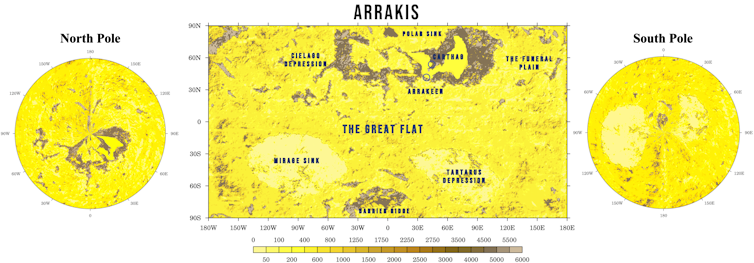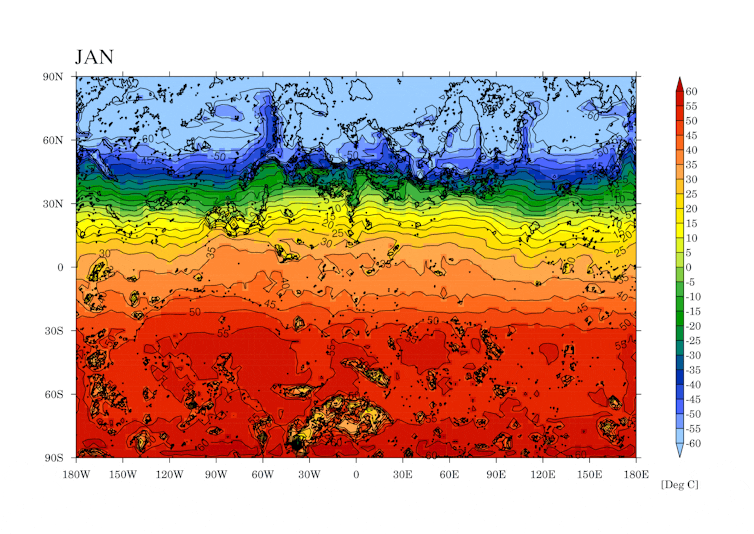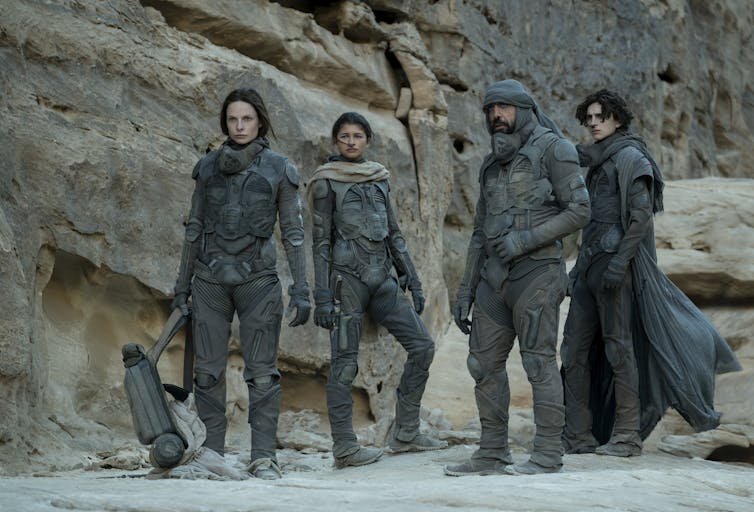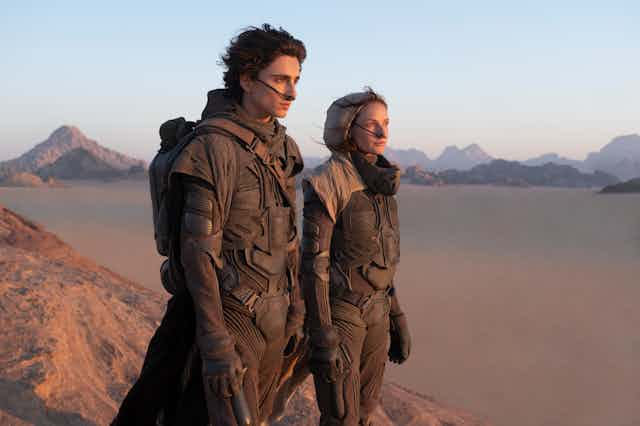Dune, the epic series of sci-fi books by Frank Herbert, now turned into a movie of the same name, is set in the far future on the desert planet of Arrakis. Herbert outlined a richly-detailed world that, at first glance, seems so real we could imagine ourselves within it.
However, if such a world did exist, what would it actually be like?
We are scientists with specific expertise in climate modelling, so we simulated the climate of Arrakis to find out. We wanted to know if the physics and environment of such a world would stack up against a real climate model.
Here’s a visualisation of our climate model of Arrakis:

You can zoom in on particular features and highlight things like temperature or wind speed at our website Climate Archive.
When we were done, we were very pleased to discover that Herbert had envisioned an environment that for the most part meets expectations. We might need to occasionally suspend disbelief, but much of Arrakis itself would indeed be habitable, albeit inhospitable.
You can listen to more articles from The Conversation, narrated by Noa, here.
How do you build a fantasy world like Arrakis?
We started with a climate model commonly used to predict weather and climate here on Earth. To use these sorts of models you have to decide on the physical laws (well-known in the case of planet Earth) and then input data on everything from the shape of mountains to the strength of the sun or the makeup of the atmosphere. The model can then simulate the climate and tell you roughly what the weather might be like.
We decided to keep the same fundamental physical laws that govern weather and climate here on Earth. If our model presented something completely strange and exotic, this could suggest those laws were different on Arrakis, or Frank Herbert’s fantastical vision of Arrakis was just that, fantasy.

We then needed to tell the climate model certain things about Arrakis, based on the detailed information found in the main novels and the accompanying Dune Encyclopedia. These included the planet’s topography and its orbit, which was was essentially circular, akin to the Earth today. The shape of an orbit can really impact the climate: see the long and irregular winters in Game of Thrones.
Finally, we told the model what the atmosphere was made of. For the most part it is quite similar to that of the Earth today, although with less carbon dioxide (350 parts per million as opposed to our 417 ppm). The biggest difference is the ozone concentration. On Earth, there is very little ozone in the lower atmosphere, only around 0.000001%. On Arrakis it is 0.5%. Ozone is important as it is around 65 times more effective at warming the atmosphere than CO₂ over a 20-year period.

Having fed in all the necessary data, we then sat back and waited. Complex models like this take time to run, in this case more than three weeks. We needed a huge supercomputer to be able to crunch the hundreds of thousands of calculations required to simulate Arrakis. However, what we found was worth the wait.
Arrakis’s climate is basically plausible
The books and film describe a planet with unforgiving sun and desolate wastelands of sand and rock. However, as you move closer to the polar regions towards the cities of Arrakeen and Carthag, the climate in the book begins to change into something that might be inferred as more hospitable.
Yet our model tells a different story. In our model of Arrakis, the warmest months in the tropics hit around 45°C, whereas in the coldest months they do not drop below 15°C. Similar to that of Earth. The most extreme temperatures would actually occur in the mid-latitudes and polar regions. Here summer can be as hot as 70°C on the sand (also suggested in the book). Winters are just as extreme, as low as -40°C in the mid-latitudes and down to -75°C in the poles.
This is counter intuitive as the equatorial region receives more energy from the sun. However, in the model the polar regions of Arrakis have significantly more atmospheric moisture and high cloud cover which acts to warm the climate since water vapour is a greenhouse gas.

The book says that there is no rain on Arrakis. However, our model does suggest that very small amounts of rainfall would occur, confined to just the higher latitudes in the summer and autumn, and only on mountains and plateaus. There would be some clouds in the tropics as well as polar latitudes, varying from season to season.
The book also mentions that polar ice caps exist, at least in the northern hemisphere, and have for a long time. But this is where the books perhaps differ the most from our model, which suggests summer temperatures would melt any polar ice, and there would be no snowfall to replenish the ice caps in winter.
Hot but habitable
Could humans survive on such a desert planet? First, we must make an assumption that the human-like people in the book and film share similar thermal tolerances to humans today. If that’s the case then, contrary to the book and film, it seems the tropics would be the most habitable area. As there is so little humidity there, survivable wet-bulb temperatures – a measure of “habitability” that combines temperature and humidity – are never exceeded.
The mid-latitudes, where most people on Arrakis live, are actually the most dangerous in terms of heat. In the lowlands, monthly average temperatures are often above 50-60°C, with maximum daily temperatures even higher. Such temperatures are deadly for humans.

We do know that all humanoid life on Arrakis outside of habitable places must wear “stillsuits”, designed to keep the wearer cool and reclaim body moisture from sweating, urination and breathing to provide drinkable water. This is important as stated in the book that there is no rainfall on Arrakis, no standing bodies of open water and little atmospheric moisture that can be reclaimed.
The planet also gets very cold outside of the tropics, with winter temperatures that would also be uninhabitable without technology. Cities like Arrakeen and Carthag would suffer from both heat and cold stress, like a more extreme version of parts of Siberia on Earth which can have both uncomfortably hot summers and brutally cold winters.
It’s important to remember that Herbert wrote the first Dune novel way back in 1965. This was two years before recent Nobel-winner Syukuro Manabe published his seminal first climate model, and Herbert did not have the advantage of modern supercomputers, or indeed any computer. Given that, the world he created looks remarkably consistent six decades on.
The authors modified a well-used climate model for exoplanet research and applied it to the planet in Dune. The work was carried out in their spare time and is intended as an appropriate outreach piece to demonstrate how climate scientists use mathematical models to better understand our world and exoplanets. It will feed into future academic outputs on desert worlds and exoplanets.


